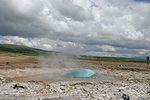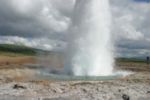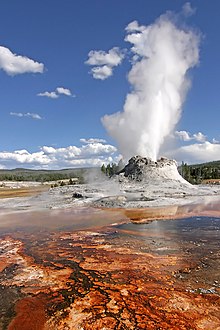Geyser
A geyser (from Geysir, name of a hot spring in Haukadalur, Iceland, whose name in turn comes from the Icelandic verb geysa, 'emanate') is a special type of hydrothermal vent that periodically emits a column of hot water and steam into the air.
The famous Geysir of Iceland is what has given the common name of geyser to these hot springs. Since 2006, the Geysir has been cordoned off for security reasons. Another famous geyser lying 25m away, Strokkur, can be seen spouting hot water every 14 minutes. In the park of Haukadalur there are a total of six geysers.
The formation of geysers requires favorable hydrogeology that exists only in a few parts of the planet, so they are a rather rare phenomenon. There are about 1,000 around the planet, of which almost half are located in Yellowstone National Park, United States.
Eruption activity of geysers may change or cease due to mineral deposition within the geyser's internal conduits —pipes—, by interchanging functions with nearby hot springs, by the influence of earthquakes, or by intervention human.
Rashes
Geyser activity, like all hot spring activity, is caused by contact between surface water and rocks heated by magma located underground. Geothermally heated water returns to the surface by convection through porous and fractured rocks. Geysers differ from other hot springs by their underground structure; many consist of a small opening to the surface connected to one or more underground tubes that connect to the water reservoirs.
As the geyser fills, the shallower water cools, but due to the narrowness of the conduit, connective cooling of the water in the reservoir is impossible. The cold water on the surface is pressed from below by the hot water, resembling the lid of a pressure cooker, causing the reserve water to superheat, keeping the liquid at temperatures above its boiling point.
Finally, the temperature at the bottom of the geyser begins to rise, reaching the boiling point; the steam bubbles rise to the tip of the duct. As it passes through the geyser crater, some of the water overflows and splashes out, reducing the width of the column and the pressure of the water below. With this release of pressure, superheated water mixes with steam, boiling violently through the column. The resulting foam between the steam and the hot water is expelled out of the geyser.
The remaining water in the geyser cools and the eruption ends; the hot water begins to filter back into the tank, and the cycle begins again. The duration of the eruptions and the time between one and another vary according to the geyser; Strokkur in Iceland erupts for a few seconds every 14 minutes, while the Grand Geyser in the United States erupts for about 10 minutes every 8 to 12 hours.
Types of geyser
There are two types of geyser:
- source geyserswhich expel water ponds, typically in series of intense, even violent explosions.
- geysers of conewhich expels siliceous cones or mounds (also known as geiserita), usually in stable jets lasting from a few seconds to many minutes. Old Faithful, probably the most famous geyser in the Yellowstone National Park, is an example of cone geysers.
The strong transient forces within geysers are the main reason for their rarity. There are many volcanic areas on the planet that have hot springs, clay pots (solfataras) and fumaroles, but very few have geysers. This is because in many places, even where other conditions for geyser activity exist, the rock structures are weak, and eruptions erode channels and rapidly destroy geysers.
Most geysers form where there are volcanic rocks like rhyolite, which dissolves in hot water and forms mineral deposits called siliceous agglomerates, or geysers, along the inside of plumbing systems. Over time, these deposits cement the rock firmly, reinforcing the channel walls and allowing the geyser to persist.
Geysers are quite a fragile phenomenon and if any condition in their environment changes they can "die". Many geysers have been destroyed due to people dumping rubbish and debris into them; others have stopped their eruptions motivated by the reduction of water by the consumption of geothermal power plants. The Great Geysir of Iceland had periods of activity and rest. During the long resting periods, the eruptions were artificially induced by humans—always for special occasions—with the addition of surfactants to the water. These activities were stopped as the forced eruptions damaged the geyser structure, especially the piping system. After an earthquake in Iceland in 2000, the geyser became somewhat more active. At first the geyser erupted about eight times a day. In July 2003, Geysir was erupting several times a week.
The specific colors of a geyser derive from the fact that despite apparently harsh conditions, life is often found within them (and even in higher temperature habitats) in the form of thermophilic prokaryotes. None of the known eukaryotes can survive in environments above 60 °C.
In the 1960s, when research into geyser biology first appeared, scientists were convinced that no life could survive in temperatures above 73 °C — the limit superior for the survival of cyanobacteria, since the structure of important proteins and deoxyribonucleic acid would be destroyed. The optimal temperature for the thermophilic bacteria was even below the previous one, close to 55 °C.
Nevertheless, the observations proved that life at elevated temperatures is possible, even some bacteria prefer temperatures above the boiling point of water. Dozens of those bacteria are known today. Thermophiles prefer temperatures between 50 and 70 °C while hyperthermophiles grow in temperatures as high as 80 or 110 °C. As they have enzymes that maintain their activity even at high temperatures, they have been used as a source of thermostable tools, which are important in medicine and biotechnology, for example to create antibiotics, plastics, detergents (due to the use of heat-stable enzymes such as lipases, pullulanases and proteases), and fermented products (ethanol is produced). The fact that such bacteria exist gives hope of finding life on other astronomical objects, inside or outside our solar system. Among these, the first to be discovered and the most important for biotechnology is Thermus aquaticus.
Number and distribution
Geysers are quite rare, requiring a peculiar combination of water and heat. This combination exists in few places on Earth near active volcanic areas with magma near the surface. The eight largest geyser fields in the world are as follows:
- Yellowstone National Park, Wyoming, United States.
- Nature Reserve Kronotski, Kamchatka Peninsula, Russia.
- El Tatio, Antofagasta Region, Chile.
- Taupo Volcanic Zone, Waikato, New Zealand.
- Haukadalur, Vesturland, Iceland.
- Valley of the Geysers, Department of Tacna, Peru.
- Copahue Volcano, Neuquén Province - Alto Biobío, Argentina - Chile
- Morning Sun (at an altitude of 4850 m. n. m.) Department of Potosí, Bolivia.
There were two large geyser fields in Nevada—Beowawe and Steamboat Springs—but they were destroyed by the installation of geothermal power plants near the site. After the installation of the plants, the drilling reduced the heat and accumulated groundwater to the point that the activity of the geysers could not continue.
There are other individual geysers around the world, in California, El Salvador, Peru, Bolivia, Mexico, Dominica, Azores, Kenya, and Japan, but no more clusters of them.
Yellowstone is the largest hydrothermal field, with hundreds of hot springs, and between three and five hundred geysers. Yellowstone has the highest geyser (Steamboat Geyser in Norris Geyser Basin) and the best known (Old Faithful in Upper Geyser Basin).
Many New Zealand geysers have been destroyed in the last century. While others have gone extinct or become inactive due to natural causes. The largest reserve is Whakarewarewa in Rotorua. Two-thirds of the Orakei Korako geysers were flooded by the Ohakuri hydroelectric dam in 1961. The Wairakei field was lost to geothermal power in 1958. The Taupo Spa field was lost when the Waikato River level was altered in the 1950s. The Rotomahana field was destroyed by the eruption of Mount Tarawera in 1886. The Waimangu Geyser which existed between 1900 and 1904 was the largest geyser ever known. It stopped being active after a landslide covered its crater. A few geysers still exist in the Taupo Volcanic Zone such as Ketetahi, Tokaanu and Waiotapu.
Alien eruptions
Geysers are not a phenomenon exclusive to planet Earth. Fountains spewing liquid nitrogen have been observed on Neptune's moon Triton. These phenomena have been called geysers. On Triton, the geysers appear to be driven by solar heat rather than geothermal energy. Nitrogen, in a liquid state due to a kind of greenhouse effect, can reach a height of 8 km when expelled.
The Cassini-Huygens mission has shown that Saturn's moon Enceladus has true water geysers, clearly photographed, in an example of so-called cryovolcanoes. Experts believe that some phenomenon (still to be explained) heats the frozen subsoil of the moon and forms liquid water reservoirs, which due to accumulated pressure break the surface ice and pour into the space of Saturn's E Ring. In fact, it is believed that the E Ring is made from the ejecta of Enceladus.
Geysers on Triton
One of the big surprises of Voyager 2's exploration of Neptune in 1989 was the discovery of geysers on its moon, Triton. The astronomers spotted steam extending about 8 km above the surface, and deposited material about 15 km downstream.
All the observed geysers were located between 40° and 60°S, close to the subpolar part of Triton. This indicates that solar heating, although weak due to distance, probably plays a crucial role. This is because Triton's surface probably consists of a semi-transparent layer of icy nitrogen, which creates a kind of greenhouse effect, heating the icy material below the layer until it breaks through the surface in an eruption. A temperature increase of just 4 K above ambient surface temperature of 38 K can cause eruptions at these observed heights.
Geothermal energy can be important too. Unusually for a large satellite, Triton orbits Neptune in a retrograde orbit—meaning it is moving in the opposite direction of Neptune's rotation. This generates tidal forces that are causing Triton's orbit to decay, implying that in several billion years it will reach its Roche limit with Neptune. Tidal forces can even generate heat within Triton, in the same way that the planet Jupiter's gravity generates tidal forces on the moon Io that drive its extreme volcanic activity.
Each eruption of a Triton geyser can last up to a year, and during this time, about 0.1 km³ of material can be deposited downwind. Voyager images of Triton's southern hemisphere show many streaks of dark material deposited by geyser activity.
Contenido relacionado
Rain forest
Dan McKenzie
Earth mantle











